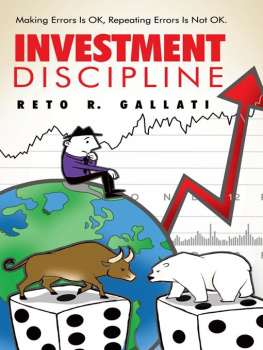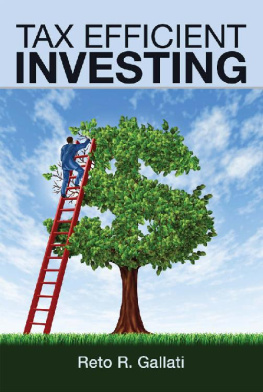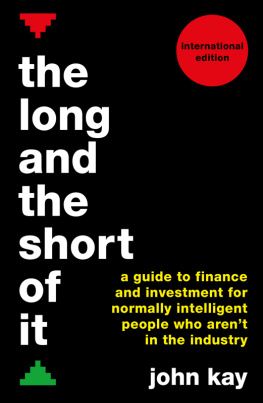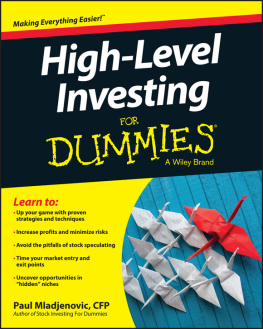Investment Discipline
Making Errors Is OK,
Repeating Errors Is Not OK.
Reto R. Gallati

Copyright 2012 Reto R. Gallati
All rights reserved. No part of this book may be used or reproduced by any means, graphic, electronic, or mechanical, including photocopying, recording, taping or by any information storage retrieval system without the written permission of the publisher except in the case of brief quotations embodied in critical articles and reviews.
ISBN: 978-1-4525-5277-4 (sc)
ISBN: 978-1-4525-5278-1 (hc)
ISBN: 978-1-4525-5276-7 (e)
Balboa Press books may be ordered through booksellers or by contacting:
Balboa Press
A Division of Hay House
1663 Liberty Drive
Bloomington, IN 47403
www.balboapress.com
1-(877) 407-4847
Because of the dynamic nature of the Internet, any web addresses or links contained in this book may have changed since publication and may no longer be valid. The views expressed in this work are solely those of the author and do not necessarily reflect the views of the publisher, and the publisher hereby disclaims any responsibility for them.
The intent of the author is only to offer information of a general nature to help you in your quest for emotional and spiritual well-being. In the event you use any of the information in this book for yourself, which is your constitutional right, the author and the publisher assume no responsibility for your actions.
Balboa Press rev. date: 7/12/2012
Contents
The views expressed in this work are solely those of the author and do not necessarily reflect the views of the publisher, and the publisher hereby disclaims any responsibility for them. The publisher and the author make no representations or warranties with respect to the accuracy or completeness of the contents of this work and specifically disclaim all warranties, including without limitation warranties of fitness for a particular purpose, no warranty may be created or extended by sales or promotional materials. This book is designed to provide accurate and authoritative information about finance and investing. The advice and strategies contained herein may not be suitable for every situation. The author and publisher will not be responsible for any liability, loss, or risk incurred as a result of the use and application of any of the information contained in this book. This work is sold with the understanding that the publisher and/or author is not engaged in rendering legal, accounting, or other professional services. Neither the publisher nor the author shall be liable for damage arising herefrom. If professional assistance is required, the services of a qualified professional person should be sought. The fact that an organization or website is referred to in this work as a citation and / or a potential source of further information does not mean that the author or the publisher endorses the information the organization or website may provide or recommendations it may make. Further, because of the dynamic nature of the Internet, any web addresses or links contained in this book may have changed since publication and may no longer be valid.
Raetia Investments, LLC., the Raetia logo are registered trademarks of Raetia Investments, LLC., and/or its affiliates in the United States and may not be used without written permission. All other trademarks are the property of their respective owners. Raetia Investments, LLC. , is not associated with any product or vendor mentioned in this book. All illustrations are copyright 2012 protected and owned by Raetia Investments, LLC.
Through the process of writing this book, I was fortunate to receive tremendous feedback from numerous colleagues and friends. I would like to take the opportunity to thank a few individuals in particular who encouraged me to publish my manuscript and make my thoughts available as a hard copy and ebook.
Celeste Cagnina has endured many evenings and weekends when I worked on this book. Without her love and unconditional support, I would not have finished this new book. Jeff Skelton, a dear friend and former colleague with vast academic and practical experience, was an invaluable sounding board throughout the process. Maurizio Ferconi, my good friend, who never hesitated to show me my errors along the way as they are obviously all mine! Stefan Riesen, my friend with whom I have shared my joy and pain as an investor since we met at Goldman. Finally, my editor Michael Whatling from McGill University, for his patience and diligence with bringing this manuscript to its highest quality.
Many highly-paid investment gurus, with a straight face and a gleam in their eye, will insist that successful investing is a function of painfully collected experience, expansive research, skillful market timing, and detailed technical analysis. Others emphasize fundamental information about companies, industries, and markets. Thats what they tell you.
I say the ingredients for a successful investment portfolio are these: stubborn belief in the quality, diversification, growth and long-term principles from Investments 101, and operations that employ the planning, leading, organizing, and controlling skills introduced in your grad class!
So, what is this book about? This book contains no secrets and no magic equations. It tells you about the most common mistakes (including my own personal errors), and provides advice on how to avoid these errors in order to become a successful investor. Key ingredients are patience, willingness to learn, some homework to understand your investments, and to top your investment process discipline.
To some people, investing is a mystery, an unpredictable world of formulas and strange terminology. Others will tell you that it is simply a matter of luck that depends on a hot tip or picking the right investment at the right time. These perceptions are common, but they are generally wrong. In fact, the principles of long-term investment success are available to anyone.
This book will guide you in your decisions from setting up your investment objectives, research, and buy/sell transaction, to adjusting your portfolio to achieve a long-term return that matches your personal objectives.
Famous investment professionals, such as Warren Buffet and Peter Lynch, have made mistakes, but they did not repeat them. They held on stubbornly to their investment approach, and showed discipline over a long time period resulting in superior returns. Obviously they were lucky as well, however they played the numbers right, and over time their performance was better than the performance of their peers.
Reto R. Gallati
Chicago, June 2012

Figure 1: Investor Profile, Mirror, mirror on the wall, who is the prettiest investor of all? Illustration by Catherine Satrun. Copyright Reto R. Gallati 2012.
investment objective
The financial goal or goals of an investor. An investor may wish to maximize current income, maximize capital gains, or set a middle course of current income with some appreciation of capital. Defining investment objectives helps to determine the investments an individual should select.
[Source: Wall Street Words: An A to Z Guide to Investment Terms for Todays Investor by David L. Scott. Copyright 2003 by Houghton Mifflin Company. Published by Houghton Mifflin Company. All rights reserved.]
1. Sharpen Your Investor Profile
One of the first steps to become a successful investor is to write down your Investment Objectives and your Investor Profile . It begins with the development of an investment plan. The first step is the identification of personal goals and objectives, and having a time frame for goal achievement. The end result should be a near autopilot, long-term and increasing wealth. Asset allocation is used to structure the portfolio so that it operates in a goal-directed manner. The finished plan must be flexible in design (to adjust for economic, political, and personal reasons), be based upon reasonable expectations, be simple in structure and operation, and be easy to supervise.
Next page







